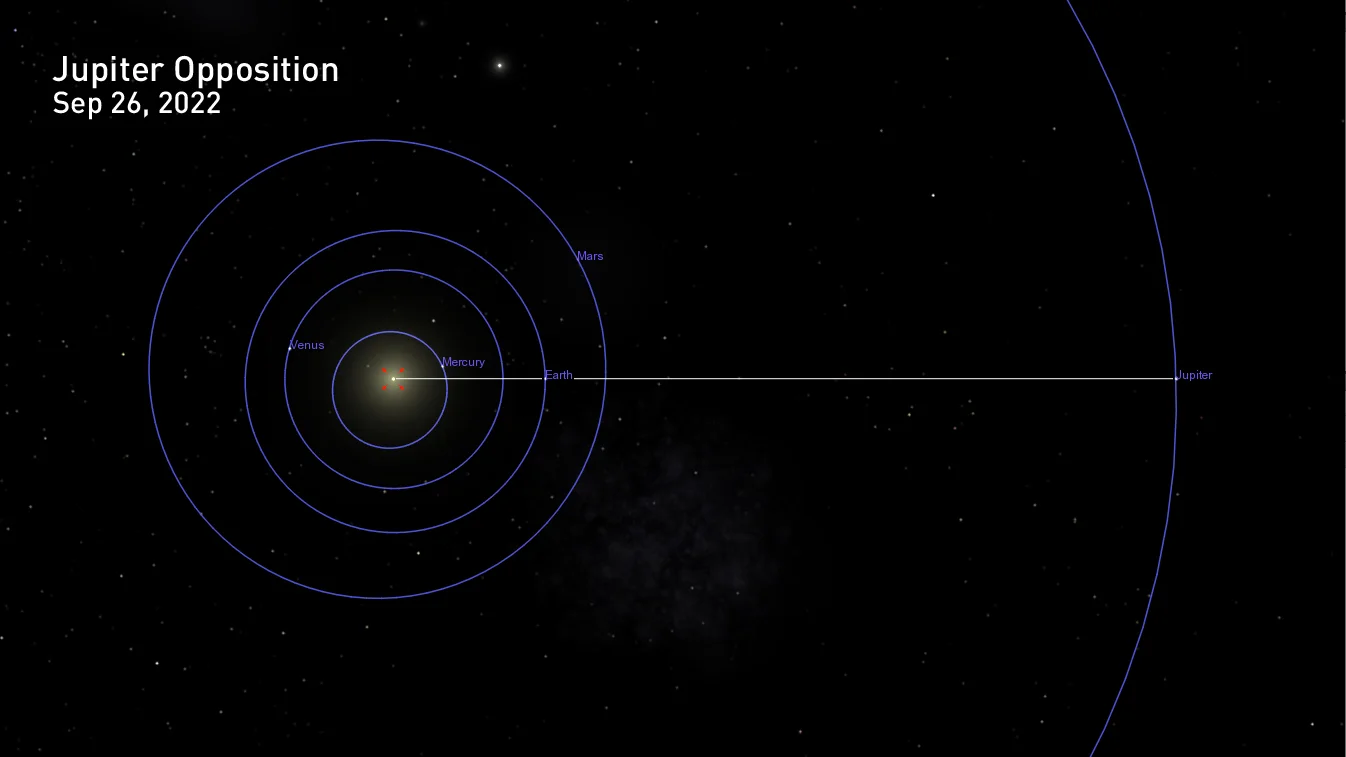
Look up tonight! Giant Jupiter shines at its brightest in over 59 years!
Not since 1963 has Jupiter appeared this bright, and it won't shine as bright again for at least another century!
The planet Jupiter is now at Opposition, and this is our chance to see it at its brightest in decades!
Throughout the year so far, each night, under clear skies, we have seen a string of bright planets stretched across the sky. Over the summer months, the most brilliant of these has been Jupiter, the largest planet in our solar system. However, keen observers may have noticed that it has been getting brighter and brighter in recent days.
This is no trick of the imagination, though. Jupiter has been getting brighter lately as Earth gets closer and closer to it, leading up to an event called Opposition.

The night sky on September 26, showing off Jupiter during Opposition. The inset shows what the planet and its four largest satellites will look like through a telescope or a good pair of binoculars. Credit: Stellarium/Scott Sutherland
So, what's going on here?
As the planets orbit the Sun, Jupiter moves relatively slowly compared to Earth. So for every one orbit the giant planet completes, Earth 'laps' it nearly 12 times!
On each of those laps, there is one moment roughly every 13 months when Earth swings around into alignment with Jupiter on the exact opposite side of our planet from the Sun. This is Jupiter Opposition.

The alignment of the planets on Sep 26, 2022, as the Sun, Earth, and Jupiter line up together. Credit: Celestia
At that time, Earth and Jupiter are at their closest distance to each other; thus, Jupiter will shine at its brightest in the night sky. This is also a great time to view the planet with a telescope or binoculars, as it becomes easier to see its cloud bands and immense Great Red Spot.
--
Read More: Look up! Fall is meteor shower season!
--
This year's Jupiter Opposition occurs tonight, September 26, and it's a special one.
Tonight, Earth and Jupiter will be 591.295 million kilometres apart. That's the closest the two planets have been since October 8, 1963, when they came within 591.283 million km of each other.
So, Jupiter is now at its brightest in nearly 59 years!
Seventy-one years ago, on October 2, 1951, the two planets were even closer together — 590.7 million km — and thus Jupiter was even brighter!

The Hubble Space Telescope captured this view of Jupiter just after Opposition in 2019. Credits: NASA, ESA, A. Simon (Goddard Space Flight Center), and M.H. Wong (University of California, Berkeley)
"With good binoculars, the banding (at least the central band) and three or four of the Galilean satellites (moons) should be visible," Adam Kobelski, a research astrophysicist at NASA's Marshall Space Flight Center, said in a post on NASA's Watch the Skies blog. "It's important to remember that Galileo observed these moons with 17th century optics. One of the key needs will be a stable mount for whatever system you use."
Having access to a mid-range backyard telescope, especially one with filters in green or blue, will provide even better views of Jupiter at this time, Kobelski says.
--
Read More: Everything you need for the perfect night of stargazing
--
"The views should be great for a few days before and after Sept. 26," Kobelski added. "So, take advantage of good weather on either side of this date to take in the sight. Outside of the Moon, it should be one of the (if not the) brightest objects in the night sky."
It will be a much longer wait before Jupiter comes even closer and thus shines even brighter — just over 107 years from now, to be more exact.
NASA's HORIZONS system, which is managed by the Jet Propulsion Laboratory in Pasadena, Calif., keeps track of every known celestial body in our solar system. According to their records, on October 6, 2129, Jupiter will reach opposition at just 590.6 million km away. That's even closer than its approach in 1951!
It will take that long to see Jupiter even brighter than tonight due to the relative orbits of Earth and Jupiter — not only their timing but their shape as well.
Both planets follow elliptical orbits around the Sun. So, they spend about half their time closer to the Sun than average and the rest of the time farther away. This also comes with two points of their orbit: closest distance to the Sun (perihelion) and farthest away (aphelion). Those distances change from orbit to orbit due to the gravitational influence of the other planets in the solar system.
For Earth and Jupiter to be at their absolute closest, a few things must match up.
First, Jupiter's Opposition would have to happen simultaneously with its closest perihelion distance. This time around, Jupiter perihelion happens on January 22, 2023. Its next one will be in early December 2034. After that, they occur roughly every 11 years and 10 months. Its closest perihelion of the next 100 years is apparently in July 2070.
Second, the date of Jupiter Opposition/Perihelion would have to occur precisely at the same time Earth was at aphelion (in early July), and it would need to be the farthest aphelion possible. Earth's most recent farthest aphelion was on July 4, 2019. It's next farthest will be on July 8, 2127.
Those factors may have lined up at some point in the past, and they will likely do so again. However, the timing doesn't work out these days. Right now, with the way Jupiter's orbit (nearly 12 years) coincides with Oppositions (roughly every 13 months), we tend to see the closest Oppositions in September or October. And even then, they happen several decades apart.
So, with the giant planet so bright in our sky right now, it represents an exceptional opportunity that we will not want to miss!
Tonight is an excellent time for astronomers of all skill levels to get outside and point their telescopes or binoculars at Jupiter to see it at its best!
(Editor's note: a previous version of this article stated that the last Jupiter Opposition closer than tonight's (591.295 million km) was 71 years ago, on October 2, 1951. While Jupiter was closer to Earth at that time (590.7 million km), it was also closer on October 8, 1963 (591.283 million km). This error has been corrected. We apologize for any confusion.)










